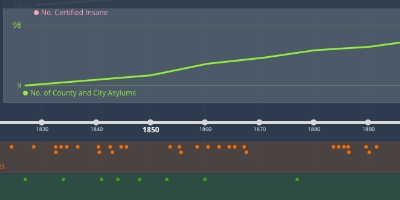nov 20, 1774 - Madhouses Act
Description:
14 Geo. III, c. 49«In 1774, Parliament responded to
’many great and dangerous abuses’ in the detention of persons in private madhouses for the rich by instituting the
practice of licensing and regulating these institutions. The resultant Private Madhouses Act laid down several principles which were to continue throughout the next century. Protection against wrongful confinement was to be ensured by inspection and certification. A commission, comprised of an elected committee of five members of the Royal College of Physicians, was responsible for the inspection of licensed houses within the county of Middlesex; provincial licensed homes were
subject to the inspections of
two county magistrates accompanied by a
’physician’. The principle of
certification was enshrined in section twenty-one, which stated that every keeper of a licensed house had to have an
’Order, in Writing, under the Hand
and Seal of some Physician, Surgeon, or Apothecary, that such Person proper to be received in to such House or Place as a Lunatick’. 21 The Act referred only to non-paupers. The Madhouses Act enshrined the principles of inspection and of medical certification, but shortcomings of the legislation were soon apparent. The Act did not stipulate what was to be done with uncertified admissions. Moreover, many provincial justices did not
comply with the licensing laws
out of ignorance or deception. Much was left to the discretion of the inspectors, who at least were given the prerogative to fine asylum keepers. There were no requirements that the medical men
certifying the lunatic be
unconnected to the receiving licensed home, thereby allowing for the possibility of collusion between medical practitioners and the asylum
proprietors,22 though it did state that members of the commission could not be keepers themselves. Despite these shortcomings, fragmentary evidence suggests that certification did begin to appear in private madhouses and voluntary asylums, and, in cases of private patients, in the new county
asylums. Anne Digby, for example, states that from the inception of the York Retreat (1796), a
voluntary asylum, patients were routinely certified prior to
confinement.23 Similarly, Charlotte MacKenzie quotes a certificate from 1803 for an admission to the private Ticehurst asylum» (Wright, 1998, p. 268).
Added to timeline:
Date:
nov 20, 1774
Now
~ 251 years ago
